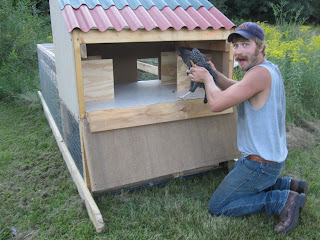What happens when you plant four tomatillo plants in your backyard garden?
You realize by the end of the summer that you've done nothing with
them and there is ripe fruit sprawling throughout that corner of the
garden. Which can mean only one thing: another canning adventure on Mainstreet! In a house without a complete kitchen, the plan was to a make a small batch of Salsa Verde for fajitas: simple, Make Dinner and Eat Salsa.
The recipes I found were a bit more involved than just a small batch for dinner. And besides I had the quantities of of ingredients for enough to can a whole batch, and then some. As I began to compare the three recipes I found, one in Balls Blue Book of preserving, the other two were web sources I realized I liked bits of all three, so I took from all to come up with this one.
Utilizing what I had available from my garden and Mom's pantry (apparently I didn't have white vinegar or cumin) and the store. Lemon Juice and Lime Juice... I've yet to get any of my citrus trees to bear fruit (let alone live) in my Minnesota backyard.
'Ser Salsa Verde es Facil'
Ingredients:
Chop & Cook:
|
8 cups of Tomatillo
2 cups of Onions
7 Ancho Hot Peppers
8 Cloves of Garlic
2 Jalapenos
|
Add:
|
½ cup of Vinegar (white)
½ cup of Lime Juice
½ cup of Lemon Juice
2 tsp Cumin
½ tsp Salt
¼ tsp Sugar
|
Directions:
Bring salsa to a boil then simmer for 20 min to an hour, or
until Salsa reaches desired thickness. Fill salsa into sterilized half pint
jars and hot water bath process for 20 mins.
After over on hour of finely chopping vegetables, my brother who was keeping me company (not helping, just keeping company) said, 'Well I am going to bed, but it looks like you've got at least another 45 minutes left of chopping those tomatillos.' At that point I decided I had enough chunks to the salsa and concluded that the rest could be blended. After adding the halved tomatillos to the blender with the vinegar needed for the recipe, I myself was in bed within 5 minutes and the chopped veggies were in the fridge waiting to be cooked down the following night.
Not knowing how it was all going to end up... and assuming it would be a better snacker salsa than a stand alone meal like my family's tomato based salsa, I decided to use tiny (4oz) jars. They are cute and could be used as single serving salsa jars or as gifts. I didn't thing a single quart jar would be a wise use of salsa or time, since it would have taken up most of the batch.I am very satisfied with the end result of the salsa... thirteen 4 oz jars. The home grown products may have slowed down the chopping, my onions were all smaller than ping pong balls. I spun quite a few LPs during the process. I could bump up the heat next time around... more Jalapenos or even Serrano peppers like one of the recipes suggested. There is a strong citrus finish that I enjoy but may scale the lemon/lime back just a bit. The white vinegar adds some acidity so there isn't such a need for citrus juice.
Mighty tasty, I found another great condiment to add to my morning egg routine.























